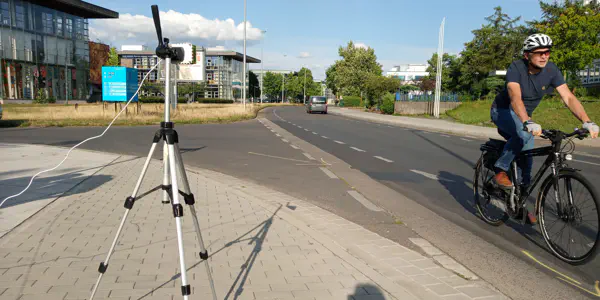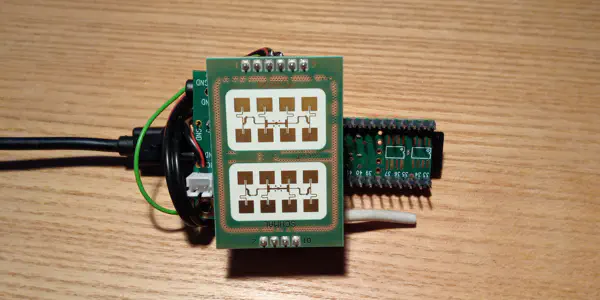This is the multi-page printable view of this section. Click here to print.
Retrospektive: Hardware
- First measurements and a lot of interest in our project
- The first prototype
- How CitRad was conceived
First measurements and a lot of interest in our project
With an initial prototype that provides data, we were finally able to invite interested parties to take measurements. At the same time, we took the opportunity to present the project at thematically appropriate events such as the Car-Free University Day or the Parking Day in Cottbus.

First live measurements on Universitätsstraße
Photo: Nanu Frechen / CC-BY-CA
Measuring under live conditions
In order to collect initial comparative data, but also to pick up interested citizens, we were drawn to the roadside relatively quickly. Using our own bicycles and cargo bikes, we generated our own trajectories and were able to compare them with “normal” road traffic. Even here, important patterns emerged that were crucial for the subsequent evaluation routine.
CitRad makes itself known

At the Parking Day in Cottbus, CitRad (briefly renamed City Radar) met with great interest and approval.
Photo: Nanu Frechen / CC-BY-CA
To make CitRad better known to the city’s population, we also ventured to various city festivals. For example, visitors to the Karlstraßenfest were able to experience their own radar signature as a sound output.
At more topic-specific events such as the Car-Free University Day, we were able to exchange ideas with mobility researchers from BTU Cottbus-Senftenberg and exchange initial ideas on where and how CitRad can be particularly effective.
We were also represented with CitRad at Parking Day 2023. This event is dedicated to critically examining the space that cars take up in urban areas through parking alone and how this can be used as an alternative to improve the quality of life in cities. CitRad also met with an interested audience here. Our approach of bringing perceived truths back to facts was consistently perceived as an important first step.
The first prototype
The CitRad sensor had to be based on a radar sensor that was as inexpensive as possible but still reliable and easy to replicate. After a few tests, we chose the IPS-354 module from Innosent. We also needed a powerful microprocessor to process the signals from the sensor. Here we opted for the Teensy 4.0 in combination with the Teensy Audio Board, which is also available. The signal from the sensor can be processed with audio tools. The Audio System Design Tool and detailed Tutorials are available for this purpose. We were particularly interested in the fact that a spectral transformation (FFT) can be implemented. In contrast to other systems, the Teensy can continue to record data while it is doing the data processing so that we do not lose any data.

The very first hardware prototype
Photo: Nanu Frechen / CC-BY-CA
A low-noise amplifier?
Initially, we were still convinced that we needed an amplifier circuit to be able to use the signal from the sensor. We tested various amplifier boards and even designed a completely custom board. In the end, however, we realized that we wouldn’t need any amplification at all if we used the 32bit Audio Library, which uses the full bandwidth of the digital converter on the audio board.
First tests
With a few jumper cables and connectors, we were now ready to assemble the very first prototype. Since laptop operation was planned at the beginning anyway, all components were supplied with power via USB cable and at the same time a data connection was established so that the data could be viewed. The results looked very promising!

First recorded data. The speed curves of several cars are visible.
Screenshot: Nanu Frechen / CC-BY-CA
How CitRad was conceived
Where do you start to make a meaningful contribution to the traffic turnaround? We pondered this for a few days at FabLab Cottbus. We quickly realized that we wanted to implement a joint project. With the participation of interested citizens from Cottbus and the surrounding area, a citizen science project was to be created that would collect traffic data and make it available to everyone for evaluation and, above all, as a basis for discussion on traffic-related decisions in the city of Cottbus.
It was not yet clear to us at the time how we wanted to collect this data. Our first thoughts were along the lines of AI-evaluated video images. Although this would not have been a technical problem, it would have raised unanswered questions and caused problems in terms of data protection.
Radar instead of video
It was a good thing that the FabLab brings together people with a wide range of knowledge. One of them had the necessary prior knowledge and the brilliant idea of using radar signals instead of video images. In one fell swoop, all data protection concerns were dispelled and the research for the best components for an initial prototype began.
Finding a name made easy
Every good project also needs a good name. Since we wanted to stick to the idea of citizen science and the radar system was now the focus, we quickly agreed on an acronym of Citizen Science Traffic Radar.